
8 minute read
TRISTEN EPPS
BLUNT WILL PHOTO:
RED ROOSTER OVERTOWN
Advertisement
Unlike most teenagers who ip burgers for minimum wage, Tristen Epps actually liked his part-time job at McDonald's; it allowed him to get out of the house for a while and, even better, make people happy. Raised by a single mom who traveled for her military job, he learned to feed himself early on. In 2009, he graduated from Johnson & Wales’ Charlotte campus and began a string of hotel kitchen jobs with e RitzCarlton, Westin Hotels & Resorts, Four Seasons Hotels and Resorts, and e Greenbrier. ere, he ascended from the apprentice program to tournant in 2012, working closely with certi ed Master Chef Richard Rosendale, who delivered rigorous, classical training. In 2014, Epps was a contestant on ABC’s e Taste, where Marcus Samuelsson became his on- and o -screen mentor. Epps was a nalist on the show but gained something arguably more prestigious than the win: the sous chef position at Samuelsson’s Red Rooster in Harlem. Samuelsson encouraged Epps to represent himself on the plate—from his Trinidadian background to his military brat travels—which gave him the con dence to open the farm-totable Cooks & Captains as executive chef in 2016. When Samuelsson needed an executive chef for Red Rooster’s Miami o shoot, Epps returned to the Marcus Samuelsson Group and moved down south in 2020. e restaurant stays true to Samuelsson’s style but is enriched by the essence of Overtown, a historically Black neighborhood, and Epps’ global vision as a chef.
eppsandflows / roosterovertown
Favorite kitchen tool: Grinder Tool you wish you had: ermoMix What you eat on your nights o : I like to eat at home on my nights o —I’m barely there. I love making Trinidadian food or, honestly, a great hot dog. Favorite food resource: Anything involving preservation or pastry Place to visit for culinary travel: Southeast Asia or West Africa
Advice to your younger self: Pay attention, work hard, and surround yourself with the same type of people. Most important kitchen rule: Improve everything you touch and respect each other.

Charred octopus, foie gras, turnip, zhug
Chef Tristen Epps of Red Rooster Overtown Adapted by StarChefs
INGREDIENTS
Zhug:
110 grams very fresh parsley, blanched 56 grams cilantro, blanched 56 grams turnip leaves, blanched 2 cardamom pods, toasted and ground 10 grams coriander seeds, toasted and ground 6 grams cumin seeds, toasted and ground 2 serrano chiles, nely chopped Kosher salt 28 grams fresh lemon juice 15 grams roasted garlic cloves 2 grams xanthan gum 120 milliliters extra virgin olive oil
Dukkah Butter:
¼ cup crushed peanuts 3 tablespoons sesame seeds 2 tablespoons cumin seeds 3 tablespoons coriander seeds 2 tablespoons crushed almonds 2 tablespoons crushed cashews 1 tablespoon fennel seeds 2 dried ancho chiles, ground into powder 1 tablespoon red chile akes or Aleppo chile akes 1 tablespoon turbinado sugar 2 cups Kikkoman panko bread crumbs Sea salt 8 ounces salted French butter, melted 1 bunch mint, chopped
Charred Octopus:
1 octopus, blanched Olive oil
Black Barbecue Sauce:
30 grams chopped shallots 40 grams chopped ginger 40 grams chopped garlic 60 grams crushed peanuts French butter 150 grams gochujang 200 grams sugar 400 grams apple cider vinegar, plus more to taste 10 grams octopus ink 56 grams foie gras Salt Black pepper
Baby Turnips:
1 bunch baby Tokyo turnips, washed, scrubbed, blanched, and halved 56 grams French butter, cold Sugar Salt Lemon juice
To Assemble and Serve:
Yield: 1 serving 2 ounces foie gras Salt Black pepper Fresh Origins micro cilantro Fresh Origins petite watercress Fresh Origins petite nasturtium leaf Pickled red onion Extra virgin olive oil METHOD
For the Zhug:
Add herbs, spices, and a few ice cubes to a Vitamix blender and blend until smooth. Add enough ice-cold water needed to get the mixture spinning freely. Add chiles and continue to blend, keeping the mixture cold. Season with salt and lemon juice, then add garlic and blend. While blending, sprinkle in xanthan gum. After 1 minute, the mixture should slightly thicken. Stream in olive oil and emulsify. Transfer to a squeeze bottle and store in refrigerator.
For the Dukkah Butter:
Add all ingredients to a mixing bowl and toss to coat seeds and nuts in butter. Transfer to a parchment-lined sheet tray and bake until toasted and fragrant. Let cool to room temperature, then crush with a mortar and pestle. Reserve.
For the Charred Octopus:
Slice octopus between the limbs to create 4 separate portions. Place octopus legs in a vacuum seal bag and add plenty of olive oil. Sous vide 5 hours at 84°C. Once cooked, remove octopus from the bag, and dry on a paper towel, reserving all liquid in the bag. Drizzle octopus with a little more olive oil and place over a very hot grill; char on both sides. Remove from grill and set aside.
For the Black Barbecue Sauce:
In a sauté pan, sauté shallots, ginger, garlic, and peanuts in butter until fragrant. Add gochujang and continue to cook as if it were tomato paste. Add sugar and caramelize, remaining careful not to burn. Deglaze with vinegar and bring to a boil. Add 500 grams reserved octopus stock from vacuum seal bag and simmer 15 minutes. Transfer all ingredients to a Vitamix blender and blend until smooth. Add ink and foie gras and blend on low speed until the sauce turns black. Season with salt and pepper as needed. Add more vinegar as needed to reach desired consistency.
For the Baby Turnips:
In a sauté pan over medium heat, add turnips, butter, a splash of water, and a pinch of sugar; reduce until glazed. Season with salt and lemon juice.
To Assemble and Serve:
Season foie gras with salt and pepper and sear until lightly charred on both sides. To a serving plate, drizzle a generous amount of Zhug and Black Barbecue Sauce. Coat one side of 1 Charred Octopus leg with Dukkah Butter and place in the middle of serving plate, Dukkah-sideup. Top with seared foie, 1 Baby Turnip half, herbs, pickled red onion, and olive oil.
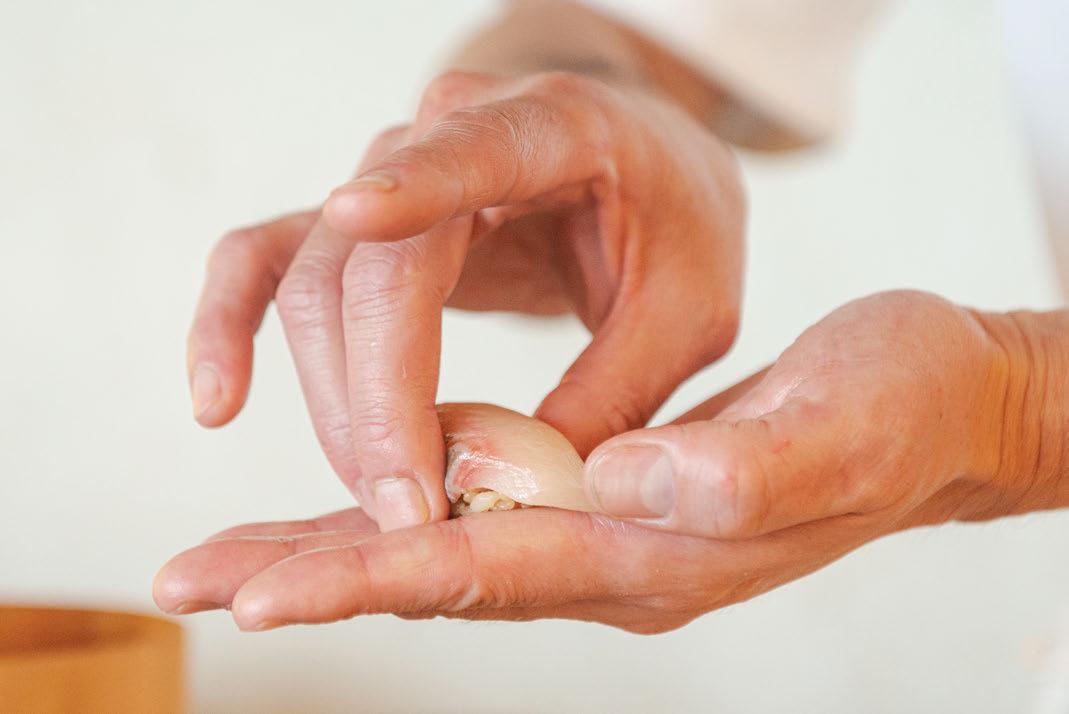
By Kendyl Kearly Although it technically only has two components, the art of nigiri is far from a simple one. Masayuki Komatsu, executive sushi chef of Hiyakawa, has honed the skill for 19 years, namely at the esteemed Morimoto and Blue Ribbon Sushi Bar & Grill. Here, we break down the two elements of Komatsu’s chub mackerel nigiri (recipe on page 83).
御飯 ( e Rice)
e most striking thing about the nigiri at Hiyakawa is the rice’s brown hue. It’s not actually brown rice but California shortgrain that has been seasoned with akazu (red rice vinegar) for a fuller avor. Komatsu says that the technique is fairly traditional to the edomae style but is something that was dropped from mainstream sushi. e red vinegar typically comes from the leftovers of sakemaking. Sushi historian Dr. Eric C. Rath, author of Oishii: e History of Sushi, says that the process for making sushi vinegar developed hundreds of years ago with the discovery that it could be produced cheaply by sealing sake, water, and vinegar in a tub for about 30 days. But, he says, “[Red vinegar is] not as widely used as other types, and it's not an indispensable ingredient for any kind of sushi that I know of.”
Komatsu says that after World War II, many Japanese people associated the brown rice with the moldy rice that was imported during food shortages. Rath con rms that white rice became a dietary mainstay in the early 1960s, though shoguns and emperors used to prefer it so much that they got beriberi, a vitamin de ciency disease.
鯖( e Fish)
Most of Komatsu’s sh is served simply raw, but the chub mackerel, imported from Chiba, Japan near Tokyo, is cured to add a saltiness to its silky fat and remove the strong shiness. Komatsu cures it with kosher salt for up to three hours, gives it an ice bath, then marinates it in vinegar and kombu. e result is a strong esh with integrity and just the right hit of oiliness. Komatsu tops the sh with a tiny bit of grated ginger and scallion and serves it with soy sauce.
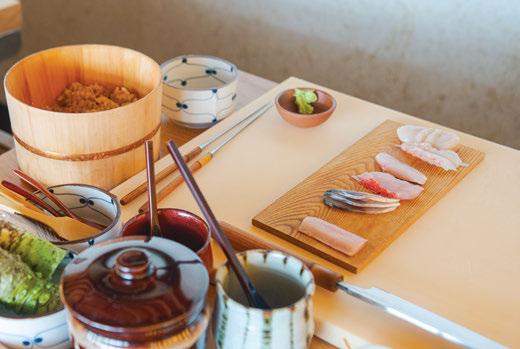
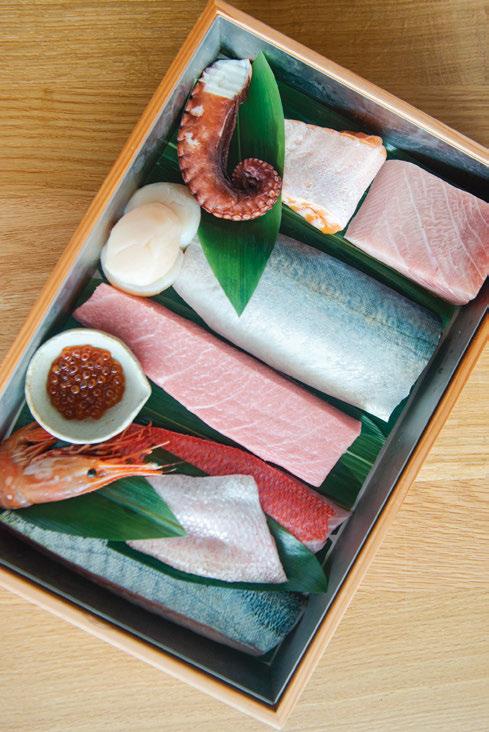
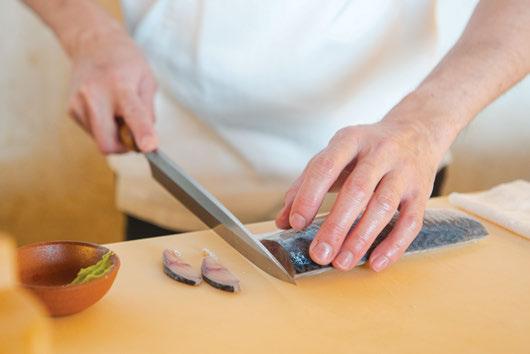
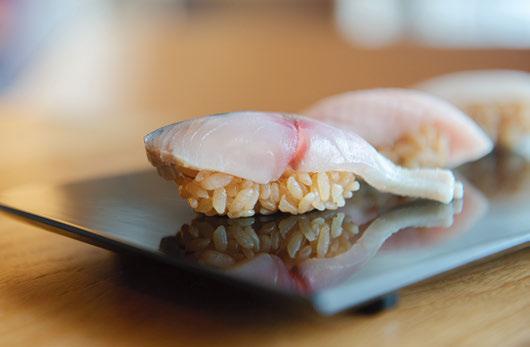
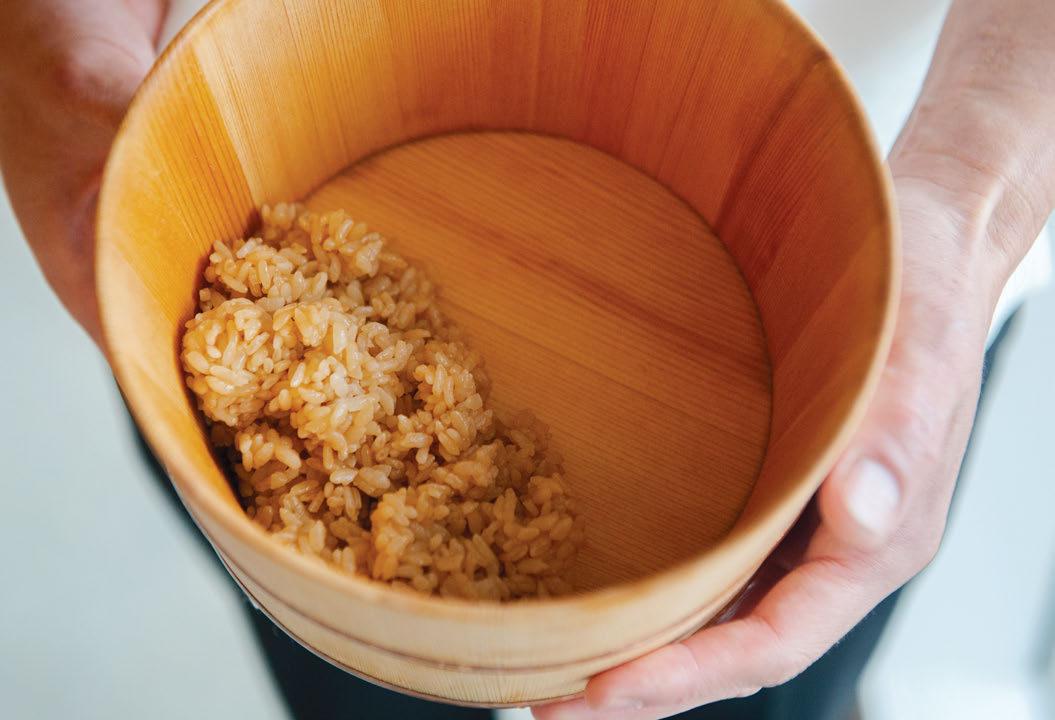
king the gre BY Aiman Javed • photographed by will blunt
When Chef-owner Henry Hané developed the menu of B Bistro + Bakery, he knew his star dish was going to be a salad: ashy with three purées, shrimp, crab, edible owers, and even gold leaf, but still, a salad. Luxurious salads are being proudly displayed at the top of menus all over Miami, from Boia De’s Luci’s Chopped Salad to Da Lida’s little gem Caesar with Calabrian chile and breadcrumbs. e large-format dishes are shareable and can therefore increase marginal revenues. e idea for Hané’s La Causa Salad (recipe on page 83) hailed from his hometown of Lima, Peru and is a deconstructed causa, traditionally a potato and ají amarillo terrine sandwiched with chicken or seafood. At $21 (with $5 extra for shrimp), it’s an expensive lunch for the typical Financial District diner, but the dish has become a staple anyway. Despite its many ingredients, high food cost, and long prep time, Hané considers it too valuable to take o the menu and a proud representation of his heritage. Here, we take a by-the-numbers look at how a salad can be such a successful menu item.
400
Pounds of potatoes used each month
$1.85
Cost of botija olives and avocados per salad
17
Number of ingredients in the salad
$11
Approximate food cost per salad with the shrimp add-on
5
Minutes needed to prepare each salad
$55
Cost of Belmont’s 15-pound tubs of ají amarillo and ají panca pastes
100
Approximate number of salads sold each week
$8
Cost of 4 ounces of crab and 4 ounces of shrimp per salad










